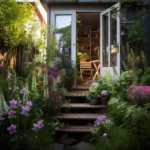From the lush hanging gardens of Babylon to the meticulously designed landscapes of European palaces, flower gardens have played a significant role in human history. They are not just places of beauty but also reflections of cultural values, technological advancements, and artistic expressions throughout the ages. This journey through time explores the evolution of historical flower gardens, highlighting their significance and the stories they tell about the societies that created them.
The Hanging Gardens of Babylon
One of the Seven Wonders of the Ancient World, the Hanging Gardens of Babylon, is perhaps the most legendary flower garden. Believed to have been constructed by King Nebuchadnezzar II for his wife, Amytis, who missed the green hills of her homeland, these gardens were an engineering marvel. They featured an ascending series of tiered gardens containing a wide variety of trees, shrubs, and flowers. Though their existence is debated, ancient texts describe an impressive irrigation system that brought water from the Euphrates River to sustain the lush vegetation in the arid Mesopotamian climate.
Ancient Egyptian Gardens
In ancient Egypt, gardens were an integral part of both public and private life. These gardens often included rows of trees, ponds, and an abundance of flowers like lotus and papyrus, which held religious and symbolic significance. Temples and tombs were adorned with gardens designed to honor the gods and provide a serene resting place for the dead. The Egyptians were among the first to practice horticulture on a grand scale, cultivating not only flowers for beauty but also plants for medicinal and culinary purposes.
Persian Paradise Gardens
The Persian gardens, known as “pairidaeza” or paradise gardens, were designed to represent an earthly vision of heaven. These enclosed gardens featured a quadripartite layout symbolizing the four Zoroastrian elements of sky, earth, water, and plants. Water played a crucial role, with intricate irrigation systems and reflecting pools creating a sense of tranquility. The gardens were lush with roses, lilies, and other fragrant flowers, creating a sensory paradise. The influence of Persian garden design can be seen in later Islamic gardens, such as those in Spain’s Alhambra.
Renaissance Gardens of Italy
The Renaissance era brought a revival of interest in classical antiquity and a new approach to garden design. Italian Renaissance gardens were characterized by geometric layouts, symmetry, and the use of perspective to create visually stunning effects. These gardens often included terraces, fountains, sculptures, and a diverse array of flowers. The Boboli Gardens in Florence and the gardens of Villa d’Este in Tivoli are prime examples, showcasing the blend of art, nature, and architecture that defined the period.
French Formal Gardens
In the 17th century, France became the epicenter of garden design with the development of the French formal garden, or “jardin à la française.” The most famous example is the gardens of Versailles, designed by André Le Nôtre for King Louis XIV. These gardens epitomized control over nature, with meticulously manicured lawns, parterres of flowers, and grand avenues radiating from a central point. The use of symmetry, order, and grandeur in these gardens reflected the absolute power and refined taste of the monarchy.
English Landscape Gardens
In contrast to the rigid formality of French gardens, the English landscape garden emerged in the 18th century as a more naturalistic approach to garden design. Inspired by the pastoral landscapes of classical paintings, these gardens featured rolling lawns, serpentine lakes, and groves of trees. Flowers were used to enhance the natural beauty rather than dominate it. Stourhead and the gardens at Blenheim Palace are quintessential examples, embodying a harmonious blend of art and nature.
Victorian Flower Gardens
The Victorian era saw a renewed interest in flower gardening, fueled by advances in plant breeding and global plant exploration. The Victorian flower garden was a riot of color and variety, with elaborate carpet bedding and an emphasis on exotic species. Public parks and private estates alike featured intricate floral displays and conservatories to house tropical plants. The Royal Botanic Gardens at Kew and the gardens at Osborne House on the Isle of Wight reflect the Victorian passion for horticulture and floral diversity.
Japanese Zen Gardens
Japanese Zen gardens, or karesansui, represent a minimalist approach to gardening that emphasizes simplicity and meditation. Unlike the colorful gardens of the West, Zen gardens use sand, rocks, and a few select plants to create a landscape that invites contemplation. These gardens are meticulously maintained to represent an idealized natural scene, with each element carefully placed to convey meaning and evoke a sense of peace. The famous Ryoan-ji garden in Kyoto is a prime example of this serene and symbolic garden style.
Historical flower gardens are more than just beautiful spaces; they are living archives of human ingenuity, culture, and artistic expression. Each era and region has left its mark on the way we design and appreciate gardens, creating a rich tapestry of styles and techniques that continue to inspire modern horticulture. Whether it’s the structured elegance of a French formal garden, the pastoral charm of an English landscape garden, or the meditative simplicity of a Japanese Zen garden, these floral sanctuaries offer us a glimpse into the values and aesthetics of the past while providing timeless inspiration for the future.


